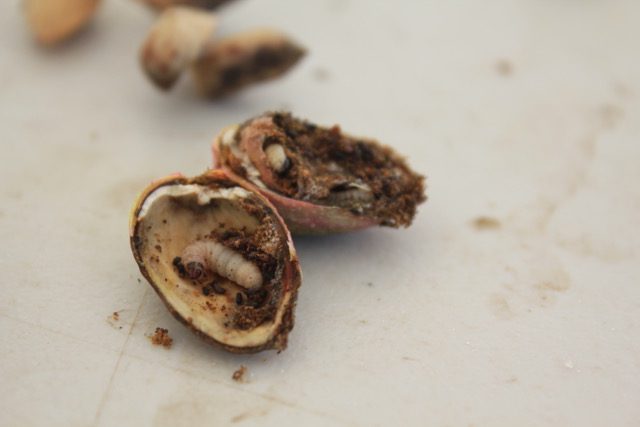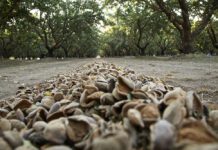Harvest samples are the ‘whodunit’ in the tree nut industry. Cracking open nuts taken at harvest from bins, trailers and orchard floors provides good information about the success or lack of success of the past season’s pest management program. Harvest sampling can also show where improvement is needed in irrigation management, nutrition and orchard sanitation. This information along with grade sheets from the processors can help growers plan for the next growing season.
Justin Nay of Integral Ag said he began collecting samples from this year’s pistachio crop soon after harvest began at the end of August. The samples are placed in a freezer to keep hulls from decaying and to stop insect development until the cracking open commences.
“We are not looking at the nuts from the perspective of the processor but as a reflection of how growers dealt with different problems during the growing season,” Nay said.
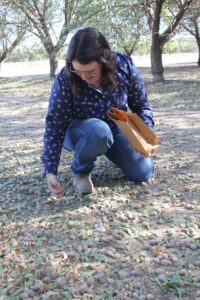
Obvious Damage Is First
Samples contain anywhere from 300 to 500 nuts from a block. As Nay looks over the sample, the first nuts pulled out are the obvious: Bot- and bug-damaged. Dark, shriveled adhering hulls are a sign of season-long decline as this disease advances. Direct feeding by plant bugs, navel orangeworm (NOW) and even birds can be seen. Nay removes hulls from all nuts in the sample to look for other defects, noting that all bug damage may not been seen from the exterior,
The fungal disease Botryosphaeria can cause collapse of the entire cluster though some shells will contain kernels and some do split open. They may or may not contain kernels.
Early split nuts are the next to be counted out. They range from underdeveloped pea splits to larger sizes where hulls and shells split at the same time. These are the nuts that can contain NOW in all larval stages. Unless removed by harvest, these nuts will harbor the next generation that will infest later harvested pistachios.
Nay called early split nuts, which will contain mold along with frass and eggs and larvae of NOW, ‘the bane of the Kerman variety.’ There is an environmental factor with early splits, he said, and while this can be managed, it cannot be controlled. Pistachio damage can also come from ants and birds.
Nay also looks at the pistachio kernels for signs of internal kernel decay. This blemish, which affects the Golden Hills variety, does not affect the nut flavor.
Further sorting will take out nuts that have adhering hulls, stained shells and are not fully developed. The grower may be paid for these nuts as ‘shelling stock’ at a lower rate than split nuts with unstained shells.
As the sampling progresses, percentages of each type of nut are recorded. High percentages of insect infestation mean decisions must be made about pesticide application and timing and orchard sanitation levels.
Nay said the samples taken from the first shake at harvest will look very different from the samples taken weeks later at second shakes. Hulls will be more degraded and more early splits and NOW infestation will be found. Careful examination of the life stages of NOW found in the early splits will show when the nuts were infested.
In addition, noting percentages of infested or diseased nuts, Nay said the samples can show effects of overirrigation and shading. Higher humidity levels in orchards will cause more crop damage.
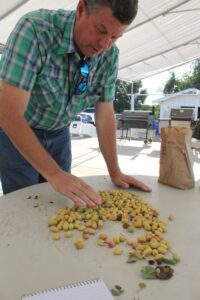
Damage in Almonds
Harvest sampling in almond follows many of the same guidelines as pistachio. Vanessa Chancellor with G.W. Osteen and Associates said the main insects that do much of the kernel damage are NOW, peach twig borer, fruit moths, ants and plant bugs.
“We are finding lots of leaffooted bugs and green stink bugs now,” Chancellor said as she surveyed a Tulare County almond orchard in mid-September.
If worms are found in samples, they can be visually identified. NOW larvae are milky white with a brown head capsule. Peach twig borer larvae are brown and white striped with a dark head capsule. Oriental fruit moths larvae are similar to NOW, but without crescent shaped markings.
Physical traits of the nuts are also noted, including doubles, shrivel and blanks. Those traits are more of a reflection of irrigation and weather. Hulls are also sent to a lab for analysis.
Chancellor said she collects samples according to a map of spray permits, which distinguishes different insecticide applications. Almond samples are collected in 20 to 40 places across a block and placed in paper bags that hold 8 lbs of nuts. The bags are marked with the field location, variety and date collected. Hard-shell varieties are sampled once, and soft-shell varieties twice, due to higher incidence of infestation. Presence of ants at collection sites are noted to help with damage identification. Samples are stored in a freezer to kill any insects inside before they are cracked to determine infestation and disease levels.
A sampling guide written by former UCCE Orchard Systems Advisor Emily Symmes noted that a stratified sample, nuts taken all layers will yield a better representation as infested nuts may weigh less and be a larger proportion of those on the top layer.
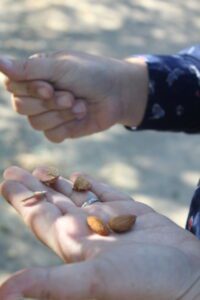
Records Help with Sampling Process
In addition, blocks with a wide variation in pest pressure may need more samples. Site-specific records of blocks can also help with the sampling process.
She also recommended if samples are refrigerated that hulls should be removed to limit rotting and movement of pests between nuts. Freezing is best for longer-term storage.
With a representative sample, nuts can be sorted according to kernel damage. NOW larvae feed in groups, leave a lot of frass and chew deep into kernels. There is also webbing visible. Plant bug feeding leaves dark spots on the kernels. There is no frass or webbing. Peach twig borer and NOW can infest the same nut, but NOW larvae bore into the nut and peach twig borer does not, and its damage is masked by NOW.
Peach twig borer and Oriental fruit moth feeding alone leaves shallow channels and a surface groove on kernels. Little to no frass or webbing is present.
Ants leave behind sawdust, which can be mistaken for frass as they scrape or peel the kernel skin and hollow out the nut.
With worm damage, noting the size and stage of development shows when the initial infestation occurred and can be compared with monitoring and treatment records to improve future pest management decisions.
Chancellor said they have identified carpophilus beetle in collected samples and samples from almond trees, and identification was confirmed by UC.

Cecilia Parsons | Associate Editor
Cecilia Parsons has lived in the Central Valley community of Ducor since 1976, covering agriculture for numerous agricultural publications over the years. She has found and nurtured many wonderful and helpful contacts in the ag community, including the UCCE advisors, allowing for news coverage that focuses on the basics of food production.
She is always on the search for new ag topics that can help growers and processors in the San Joaquin Valley improve their bottom line.
In her free time, Cecilia rides her horse, Holly in ranch versatility shows and raises registered Shetland sheep which she exhibits at county and state fairs during the summer.







